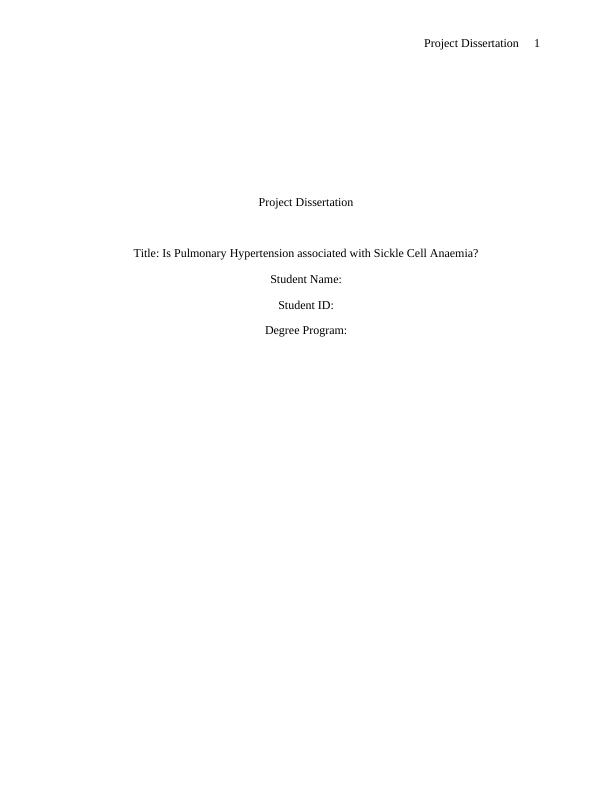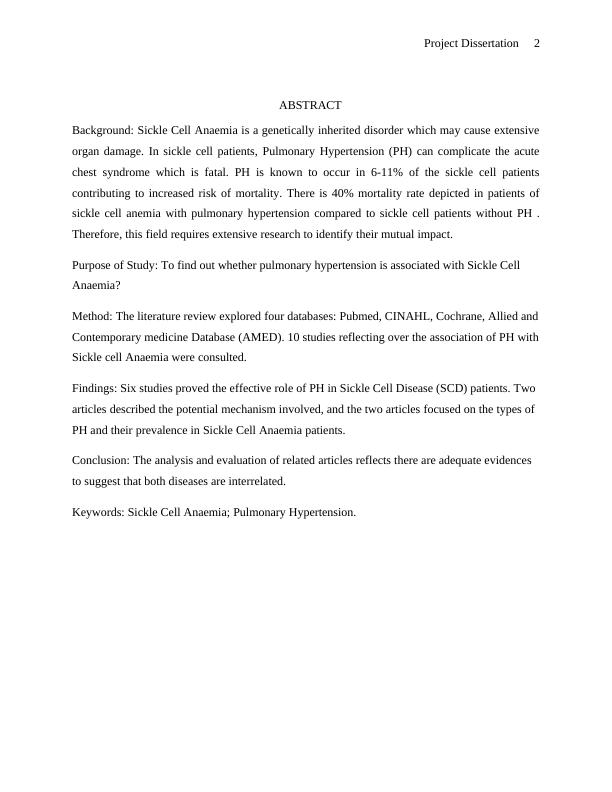Is Pulmonary Hypertension associated with Sickle Cell Anaemia?
Added on 2023-01-11
27 Pages7355 Words68 Views
Project Dissertation 1
Project Dissertation
Title: Is Pulmonary Hypertension associated with Sickle Cell Anaemia?
Student Name:
Student ID:
Degree Program:
Project Dissertation
Title: Is Pulmonary Hypertension associated with Sickle Cell Anaemia?
Student Name:
Student ID:
Degree Program:

Project Dissertation 2
ABSTRACT
Background: Sickle Cell Anaemia is a genetically inherited disorder which may cause extensive
organ damage. In sickle cell patients, Pulmonary Hypertension (PH) can complicate the acute
chest syndrome which is fatal. PH is known to occur in 6-11% of the sickle cell patients
contributing to increased risk of mortality. There is 40% mortality rate depicted in patients of
sickle cell anemia with pulmonary hypertension compared to sickle cell patients without PH .
Therefore, this field requires extensive research to identify their mutual impact.
Purpose of Study: To find out whether pulmonary hypertension is associated with Sickle Cell
Anaemia?
Method: The literature review explored four databases: Pubmed, CINAHL, Cochrane, Allied and
Contemporary medicine Database (AMED). 10 studies reflecting over the association of PH with
Sickle cell Anaemia were consulted.
Findings: Six studies proved the effective role of PH in Sickle Cell Disease (SCD) patients. Two
articles described the potential mechanism involved, and the two articles focused on the types of
PH and their prevalence in Sickle Cell Anaemia patients.
Conclusion: The analysis and evaluation of related articles reflects there are adequate evidences
to suggest that both diseases are interrelated.
Keywords: Sickle Cell Anaemia; Pulmonary Hypertension.
ABSTRACT
Background: Sickle Cell Anaemia is a genetically inherited disorder which may cause extensive
organ damage. In sickle cell patients, Pulmonary Hypertension (PH) can complicate the acute
chest syndrome which is fatal. PH is known to occur in 6-11% of the sickle cell patients
contributing to increased risk of mortality. There is 40% mortality rate depicted in patients of
sickle cell anemia with pulmonary hypertension compared to sickle cell patients without PH .
Therefore, this field requires extensive research to identify their mutual impact.
Purpose of Study: To find out whether pulmonary hypertension is associated with Sickle Cell
Anaemia?
Method: The literature review explored four databases: Pubmed, CINAHL, Cochrane, Allied and
Contemporary medicine Database (AMED). 10 studies reflecting over the association of PH with
Sickle cell Anaemia were consulted.
Findings: Six studies proved the effective role of PH in Sickle Cell Disease (SCD) patients. Two
articles described the potential mechanism involved, and the two articles focused on the types of
PH and their prevalence in Sickle Cell Anaemia patients.
Conclusion: The analysis and evaluation of related articles reflects there are adequate evidences
to suggest that both diseases are interrelated.
Keywords: Sickle Cell Anaemia; Pulmonary Hypertension.

Project Dissertation 3
CHAPTER 1- INTRODUCTION
1.1. Background
Sickle Cell Anemia is a blood disorder mainly occurring due to genetic inheritance of abnormal
protein in the RBCs which makes them distorted and sickle shaped (National Heart, Lung and
Blood Institute, 2018). It is characterized by the substitution of amino acids in beta globin chain
due to presence of homozygous hemoglobin SS (Klings and Farber,2019).
The disease is mostly prevalent in African Americans(National Heart, Lung and Blood Institute,
2018) . It is an autosomal recessive disorder in which the polymerization of Hemoglobin-S
occurs upon deoxygenation. The polymerization increases the sickling and rigidity of red blood
cells. It injures the RBCs and reduces the blood circulation in them. The resulting complications
cause microvascular occlusions leading to injury of several body organs like kidney, lungs,
spleen, liver, central nervous system and severe pain in abdomen, joints, back and chest. The
sickle cell anaemia when associated with pulmonary hypertension, results into elevated risk of
early deaths, elevated WBC count> 15000 cell/mm3, seizures and renal failures (Ataga and
Clinggs, 2014).
Pulmonary Hypertension (PH) refers to a condition of high blood pressure (where resting
Pulmonary artery pressure >25 mmHg) developed within the arteries in the lungs and the heart
(Pulmonary Hypertension Association, 2019). PH may occur due to any illness that obstructs the
normal blood flow in the lungs for sustained periods. For example: collagen vascular disease,
liver cirrhosis, chronic lung disease and thromboembolism. The clinical symptoms and signs
exhibited by the patients of PH are Chronic Dyspnea, Hypoxemia, elevated tricuspid
regurgitation, Syncope, Arrhythmias, Cor Pulmonale and early death.
The sickle cell disease (SCD) patients have enhanced cardiac output due to anaemia. It is
observed that pulmonary vascular resistance and pulmonary pressures are higher in patients of
Sickle cell disease with Pulmonary Hypertension. Their cardiac output is also higher than the
normal range. These patients exhibit high rate of fatigue on exertion.
Haemodynamic Normal Range Sickle Cell Patients Sickle Cell Patients
CHAPTER 1- INTRODUCTION
1.1. Background
Sickle Cell Anemia is a blood disorder mainly occurring due to genetic inheritance of abnormal
protein in the RBCs which makes them distorted and sickle shaped (National Heart, Lung and
Blood Institute, 2018). It is characterized by the substitution of amino acids in beta globin chain
due to presence of homozygous hemoglobin SS (Klings and Farber,2019).
The disease is mostly prevalent in African Americans(National Heart, Lung and Blood Institute,
2018) . It is an autosomal recessive disorder in which the polymerization of Hemoglobin-S
occurs upon deoxygenation. The polymerization increases the sickling and rigidity of red blood
cells. It injures the RBCs and reduces the blood circulation in them. The resulting complications
cause microvascular occlusions leading to injury of several body organs like kidney, lungs,
spleen, liver, central nervous system and severe pain in abdomen, joints, back and chest. The
sickle cell anaemia when associated with pulmonary hypertension, results into elevated risk of
early deaths, elevated WBC count> 15000 cell/mm3, seizures and renal failures (Ataga and
Clinggs, 2014).
Pulmonary Hypertension (PH) refers to a condition of high blood pressure (where resting
Pulmonary artery pressure >25 mmHg) developed within the arteries in the lungs and the heart
(Pulmonary Hypertension Association, 2019). PH may occur due to any illness that obstructs the
normal blood flow in the lungs for sustained periods. For example: collagen vascular disease,
liver cirrhosis, chronic lung disease and thromboembolism. The clinical symptoms and signs
exhibited by the patients of PH are Chronic Dyspnea, Hypoxemia, elevated tricuspid
regurgitation, Syncope, Arrhythmias, Cor Pulmonale and early death.
The sickle cell disease (SCD) patients have enhanced cardiac output due to anaemia. It is
observed that pulmonary vascular resistance and pulmonary pressures are higher in patients of
Sickle cell disease with Pulmonary Hypertension. Their cardiac output is also higher than the
normal range. These patients exhibit high rate of fatigue on exertion.
Haemodynamic Normal Range Sickle Cell Patients Sickle Cell Patients

Project Dissertation 4
Measure without PH with PH
Pulmonary Artery
Pressure
7 to 19 19+-45 36+-8
Cardiac Output 4.4 to 8.4 9+-3 8.6+-2
Pulmonary Vascular
Resistance
11-99 83+-46 205+-112
Table 1. Shows Comparison of Pulmonary Hemodynamic in Sickle Cell patients with PH
The SCD patients having PH have high mortality rate than the SCD patients without any PH. A
research by Castro colleagues in 2003 evaluated 34 adults who had undergone right heart
catheterization (Clarke, 2019). Initially, 20 of them had Pulmonary Hypertension. After a regular
follow up of 54 months, 11 out of 20 had died while only 3 patients died out of 14 having no
Pulmonary Hypertension (Clarke, 2019). The patients who died had a 10 mm Hg rise in their
mean Arterial pulmonary pressure leading to increase in rate of mortality.
Figure 1. Shows Kaplan Meier Survival in SCD patients with or without PH (Source: Clarke, 2019)
The upper red line in the graph shows the estimate survival of patients having Sickle cell disease,
without any PH. The blue line shows the estimate survival of the patients having Sickle Cell
Anaemia with PH. The time in months exhibited by X axis is the months of follow up post
catheterization of heart.
The prevalence of Pulmonary Hypertension increases in the patients of Sickle Cell Anaemia
with age. The prevalence is nearly 40% in the patients aged 40-49 years, while it is 55-60% in
Measure without PH with PH
Pulmonary Artery
Pressure
7 to 19 19+-45 36+-8
Cardiac Output 4.4 to 8.4 9+-3 8.6+-2
Pulmonary Vascular
Resistance
11-99 83+-46 205+-112
Table 1. Shows Comparison of Pulmonary Hemodynamic in Sickle Cell patients with PH
The SCD patients having PH have high mortality rate than the SCD patients without any PH. A
research by Castro colleagues in 2003 evaluated 34 adults who had undergone right heart
catheterization (Clarke, 2019). Initially, 20 of them had Pulmonary Hypertension. After a regular
follow up of 54 months, 11 out of 20 had died while only 3 patients died out of 14 having no
Pulmonary Hypertension (Clarke, 2019). The patients who died had a 10 mm Hg rise in their
mean Arterial pulmonary pressure leading to increase in rate of mortality.
Figure 1. Shows Kaplan Meier Survival in SCD patients with or without PH (Source: Clarke, 2019)
The upper red line in the graph shows the estimate survival of patients having Sickle cell disease,
without any PH. The blue line shows the estimate survival of the patients having Sickle Cell
Anaemia with PH. The time in months exhibited by X axis is the months of follow up post
catheterization of heart.
The prevalence of Pulmonary Hypertension increases in the patients of Sickle Cell Anaemia
with age. The prevalence is nearly 40% in the patients aged 40-49 years, while it is 55-60% in

Project Dissertation 5
the patients with age 50 years or more. According to NIH Howard Research published in 2004,
the risk factors for Pulmonary Hypertension in Sickle Cell Anaemia are history of cardiac or
renal diseases, systemic blood pressure, age, degree of hemolysis, cholestasis and iron overload
(Clarke, 2019). Such evidences show that the frequency of PH is increasing in the patients of
Sickle Cell Anaemia.
1.2 . Pathophysiology of Pulmonary Hypertension in patients of Sickle Cell Anaemia
Pathogenesis of Pulmonary Hypertension can be elaborated in patients of Sickle Cell Disease in
terms of several mechanisms such as Intravascular Hemolysis resulting into Nitric Oxide (NO)
deficiency, vasculopathy due to intimal thickening and platelet activation, interstitial fibrosis due
to ACS, hypoperfusion of pulmonary blood vessels of the lungs, in-situ thrombosis and recurrent
thromboembolic disease.
Nitric Oxide is produced by the NO Synthase (NOS) Enzymes which convert Arginine into the
Cittruline, while releasing NO in the process. NO produces cyclic Guanosine 3’5’
monophosphate (cGMP) in myocytes which vasodilates the myocyte wall (Clarke, 2019). In
Sickle Cell Disease, intravascular deficiency of Nitric Oxide leads to vasoconstriction of
pulmonary vessels.
Figure 2. Shows the factors involved in the release and inhibition of NO Radical. (Source: Clarke, 2019)
the patients with age 50 years or more. According to NIH Howard Research published in 2004,
the risk factors for Pulmonary Hypertension in Sickle Cell Anaemia are history of cardiac or
renal diseases, systemic blood pressure, age, degree of hemolysis, cholestasis and iron overload
(Clarke, 2019). Such evidences show that the frequency of PH is increasing in the patients of
Sickle Cell Anaemia.
1.2 . Pathophysiology of Pulmonary Hypertension in patients of Sickle Cell Anaemia
Pathogenesis of Pulmonary Hypertension can be elaborated in patients of Sickle Cell Disease in
terms of several mechanisms such as Intravascular Hemolysis resulting into Nitric Oxide (NO)
deficiency, vasculopathy due to intimal thickening and platelet activation, interstitial fibrosis due
to ACS, hypoperfusion of pulmonary blood vessels of the lungs, in-situ thrombosis and recurrent
thromboembolic disease.
Nitric Oxide is produced by the NO Synthase (NOS) Enzymes which convert Arginine into the
Cittruline, while releasing NO in the process. NO produces cyclic Guanosine 3’5’
monophosphate (cGMP) in myocytes which vasodilates the myocyte wall (Clarke, 2019). In
Sickle Cell Disease, intravascular deficiency of Nitric Oxide leads to vasoconstriction of
pulmonary vessels.
Figure 2. Shows the factors involved in the release and inhibition of NO Radical. (Source: Clarke, 2019)

Project Dissertation 6
Low level of Arginine during the VOC, show depletion of substrates which further reduces the
production of Nitric Oxide (Clarke, 2019). All these factors contribute to the mechanism of
pulmonary hypertension.
Almost half of the patients of SCD having pulmonary hypertension exhibit: (1) a state of NO
deficiency; (2) Chronic pulmonary thrombo-embolism; (3) Microvascular obstruction, low
Oxygen Saturation, and hypoxic response to anaemia (Gordeuk, Castro and Machado, 2016).
The management of patients with SCD and PH is based on anticoagulation for the patients of
thromboembolism; treatment of failure of left ventricle in the patients of post capillary
pulmonary hypertension; oxygen therapy for the patients having low saturation level; and blood
transfusions to elevate the concentration of hemoglobin, to prevent the incidents of vaso-
occlusion and lower down the rate of hemolysis. These patients need to be sent to special centres
and should be treated with the therapies found effective in treating several other PH conditions.
Reports have found such treatments to be successful in several cases (Gordeuk, Castro and
Machado, 2016).
1.3. Significance of the Study
Not all the patients of sickle cell anaemia develop pulmonary hypertension however still the
people who are the patients of SCD are more likely to develop pulmonary hypertension. The
people who have both of these diseases are at high risk of death than the patients having only one
of them. According to Pulmonary Hypertension Studies (2019), about 75% of the SCD patients
develop changes in their lung tissues during death which indicates the presence of Pulmonary
Hypertension. Pulmonary Hypertension occurs in 6-11% of the SCD patients and is identified by
the WHO as having highly variable hemodynamics leading to premature deaths (Hayes, et al.
2014). The risk factors leading to the severity of disease are increasingly a concern for the
pulmonologists, cardiologists, hematologists and internists.
This study will explore the literature review less than 10 year old, to assess the potential
association between the two diseases and factors affecting the involvement of PH in contributing
Low level of Arginine during the VOC, show depletion of substrates which further reduces the
production of Nitric Oxide (Clarke, 2019). All these factors contribute to the mechanism of
pulmonary hypertension.
Almost half of the patients of SCD having pulmonary hypertension exhibit: (1) a state of NO
deficiency; (2) Chronic pulmonary thrombo-embolism; (3) Microvascular obstruction, low
Oxygen Saturation, and hypoxic response to anaemia (Gordeuk, Castro and Machado, 2016).
The management of patients with SCD and PH is based on anticoagulation for the patients of
thromboembolism; treatment of failure of left ventricle in the patients of post capillary
pulmonary hypertension; oxygen therapy for the patients having low saturation level; and blood
transfusions to elevate the concentration of hemoglobin, to prevent the incidents of vaso-
occlusion and lower down the rate of hemolysis. These patients need to be sent to special centres
and should be treated with the therapies found effective in treating several other PH conditions.
Reports have found such treatments to be successful in several cases (Gordeuk, Castro and
Machado, 2016).
1.3. Significance of the Study
Not all the patients of sickle cell anaemia develop pulmonary hypertension however still the
people who are the patients of SCD are more likely to develop pulmonary hypertension. The
people who have both of these diseases are at high risk of death than the patients having only one
of them. According to Pulmonary Hypertension Studies (2019), about 75% of the SCD patients
develop changes in their lung tissues during death which indicates the presence of Pulmonary
Hypertension. Pulmonary Hypertension occurs in 6-11% of the SCD patients and is identified by
the WHO as having highly variable hemodynamics leading to premature deaths (Hayes, et al.
2014). The risk factors leading to the severity of disease are increasingly a concern for the
pulmonologists, cardiologists, hematologists and internists.
This study will explore the literature review less than 10 year old, to assess the potential
association between the two diseases and factors affecting the involvement of PH in contributing

End of preview
Want to access all the pages? Upload your documents or become a member.
Related Documents
HbS binding to GP1bα Activates Platelets in Sickle Cell diseaselg...
|22
|6294
|313
HbS binding to GP1bα Activates Platelets in Sickle Cell diseaselg...
|22
|6294
|174
How Smoking and Drinking Affect Patients with Sickle Cell Diseaselg...
|4
|814
|150
Parental Care Practices for Sickle-cell Disease (SCD)lg...
|10
|2516
|146
Mr. Smith’s Pathophysiology Book Assignmentlg...
|4
|636
|15
Common Disorders in Mortuary Sciencelg...
|4
|855
|217